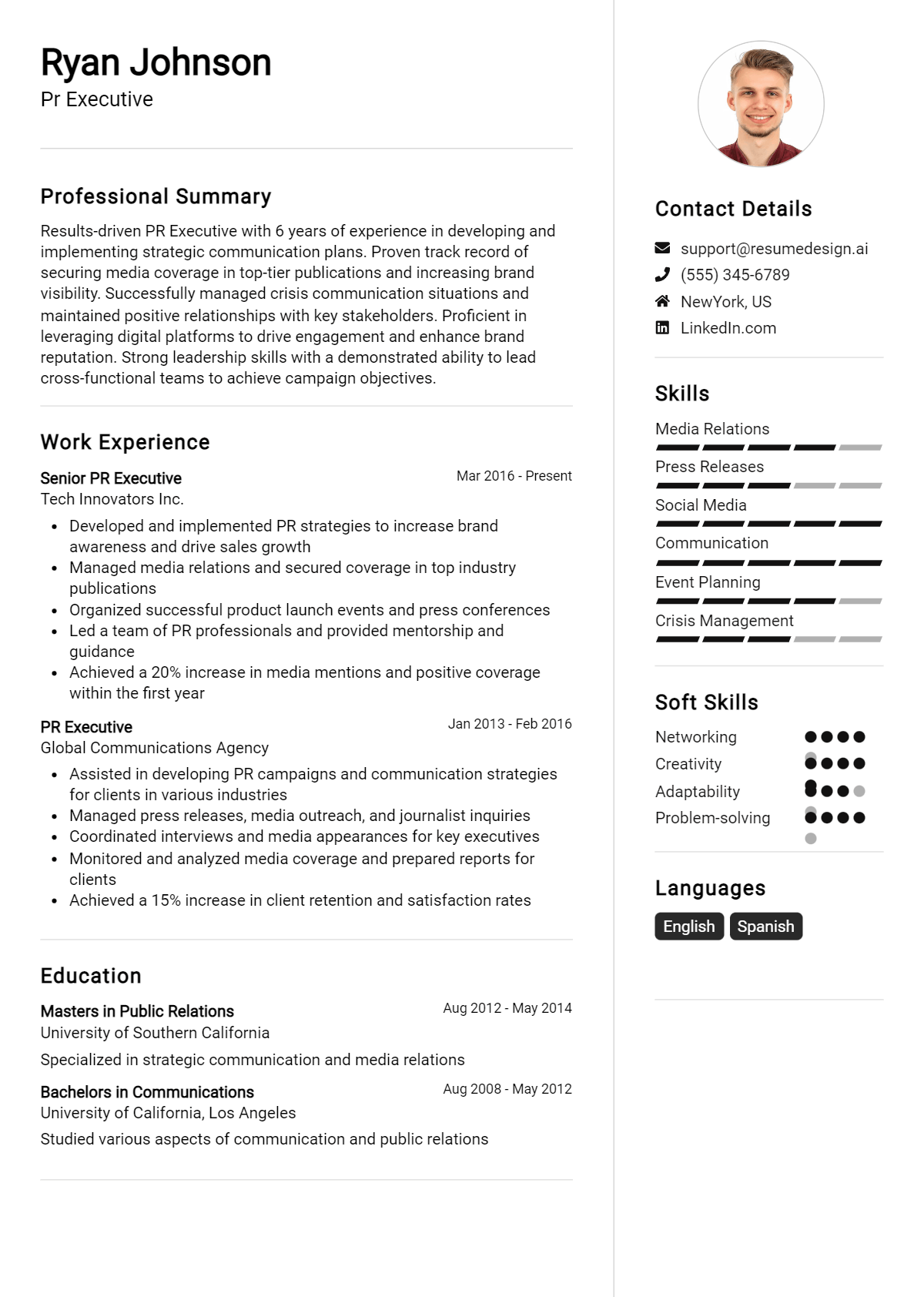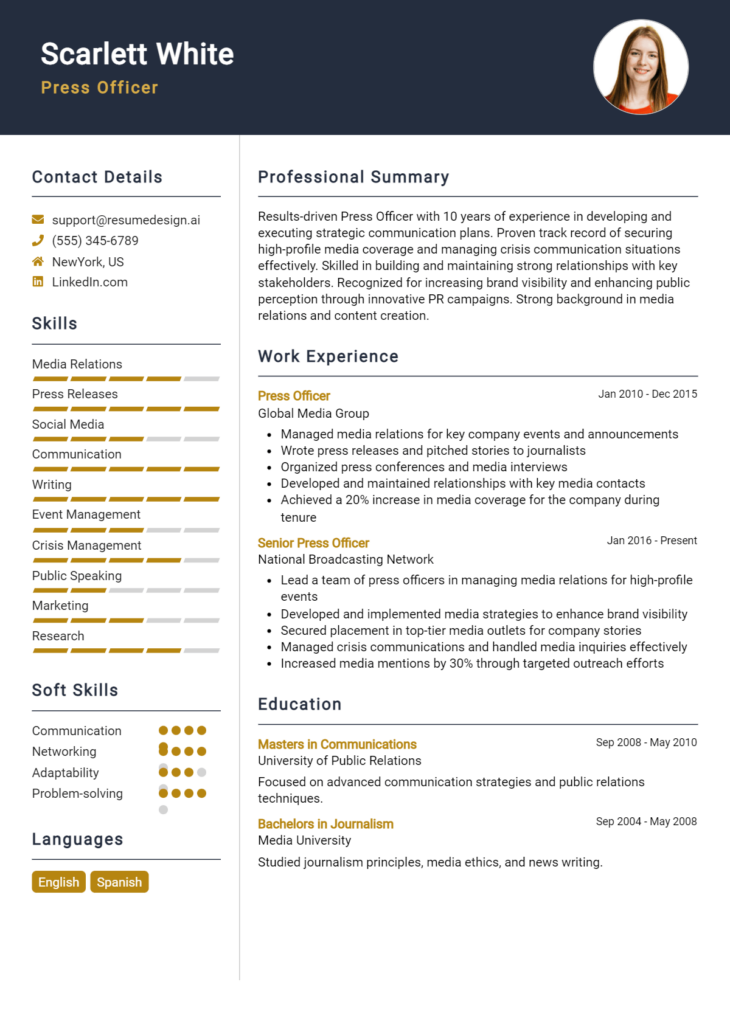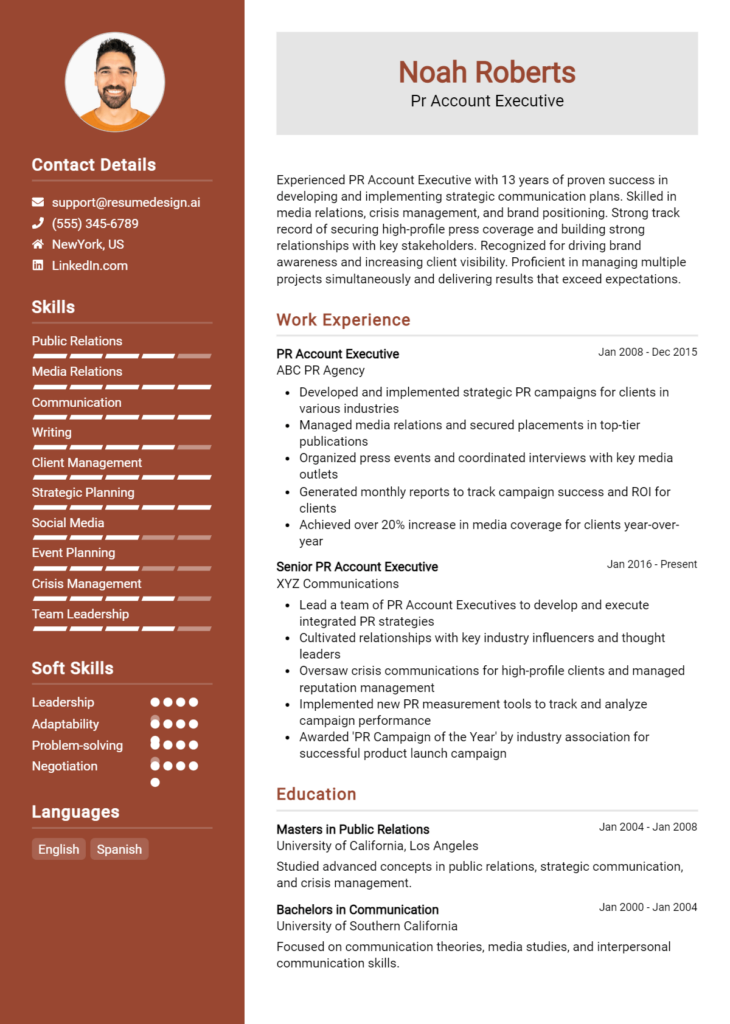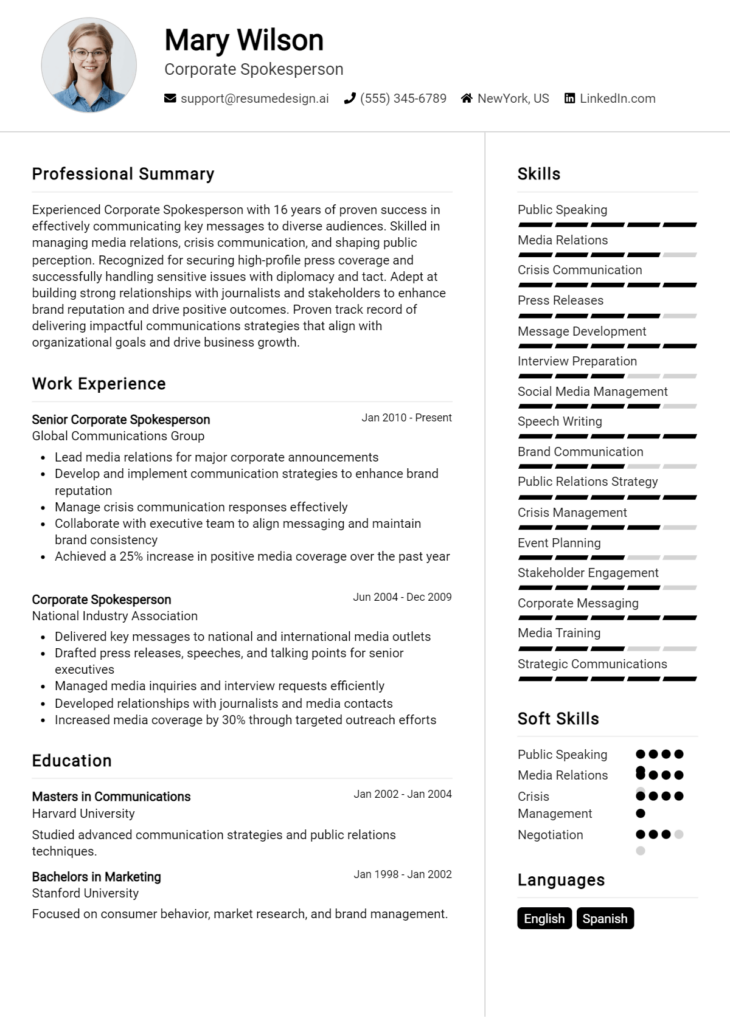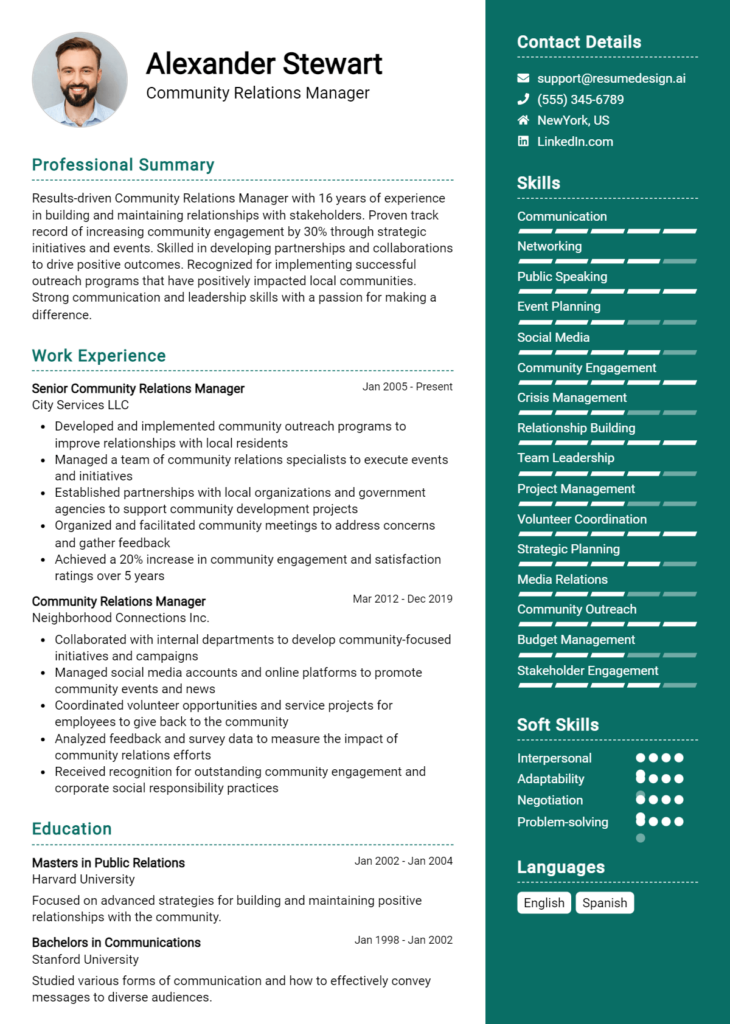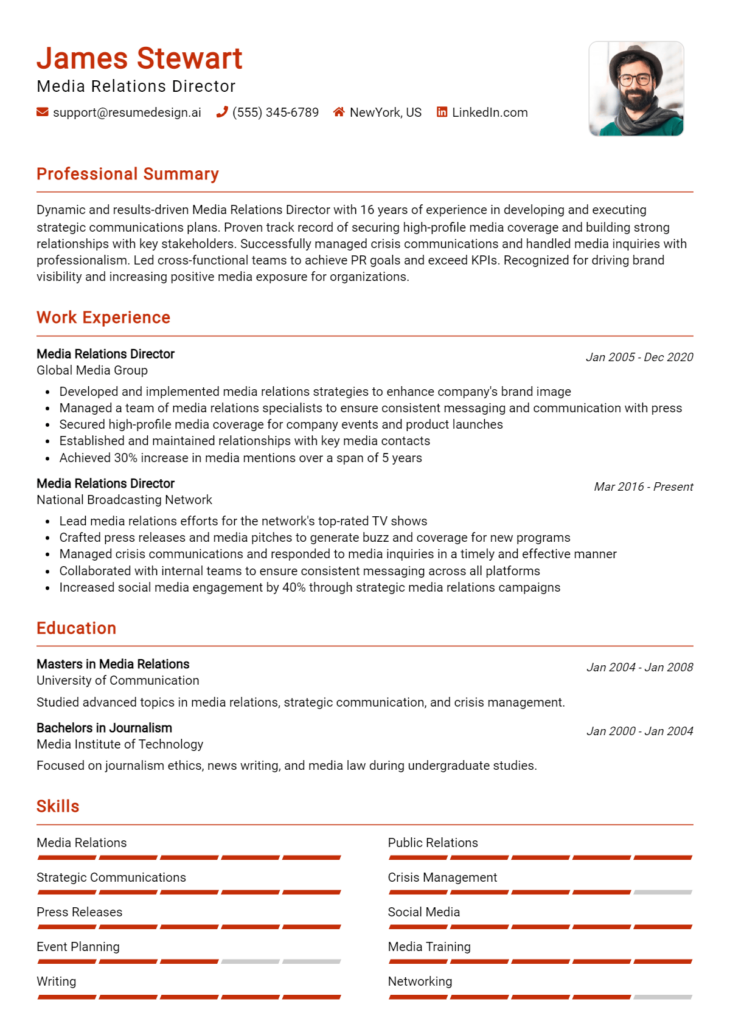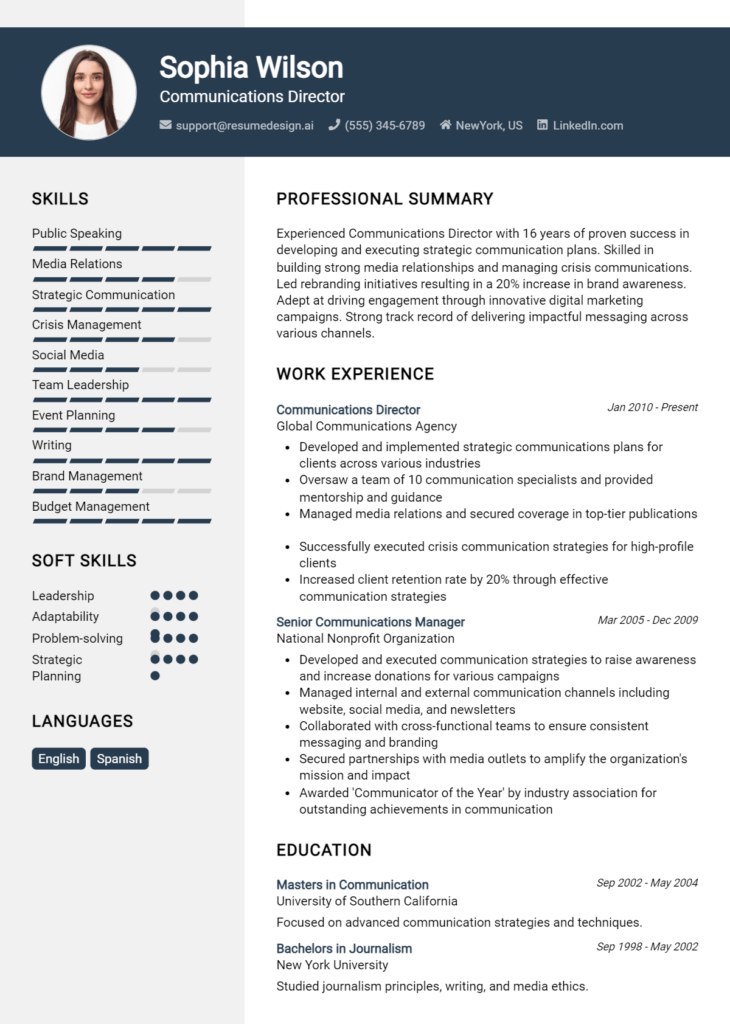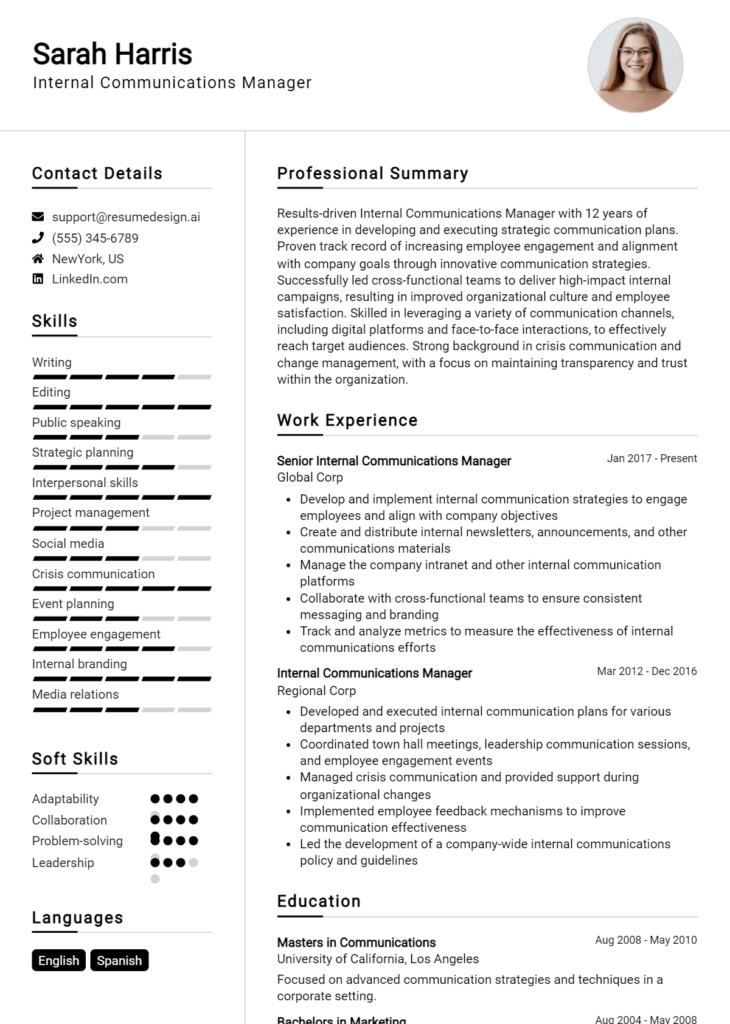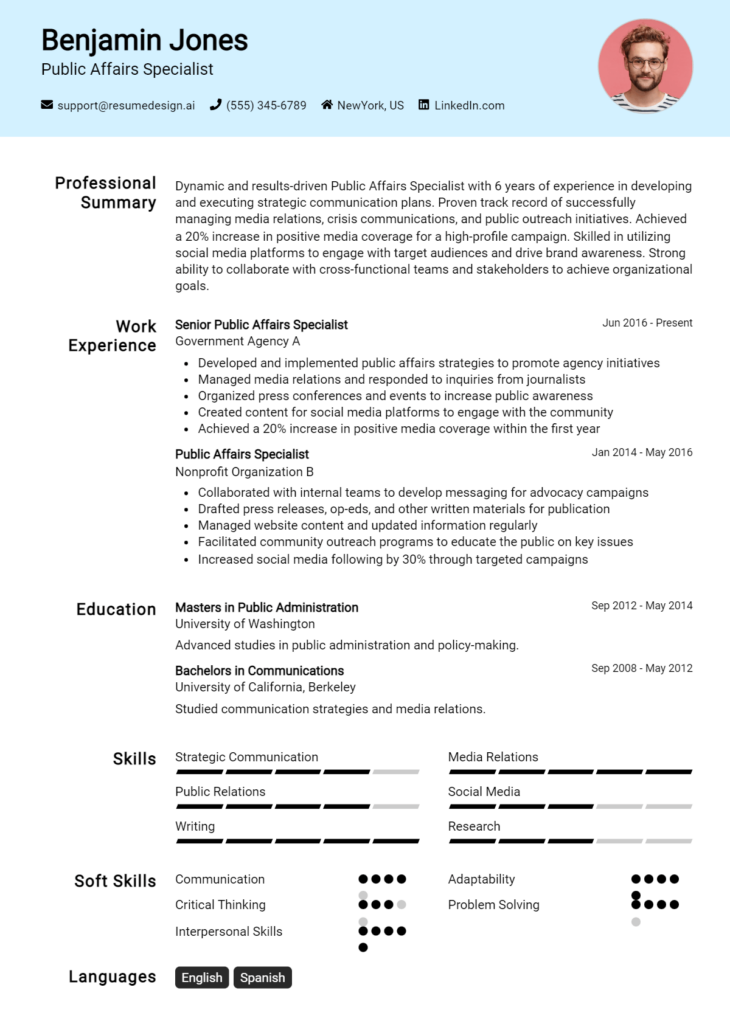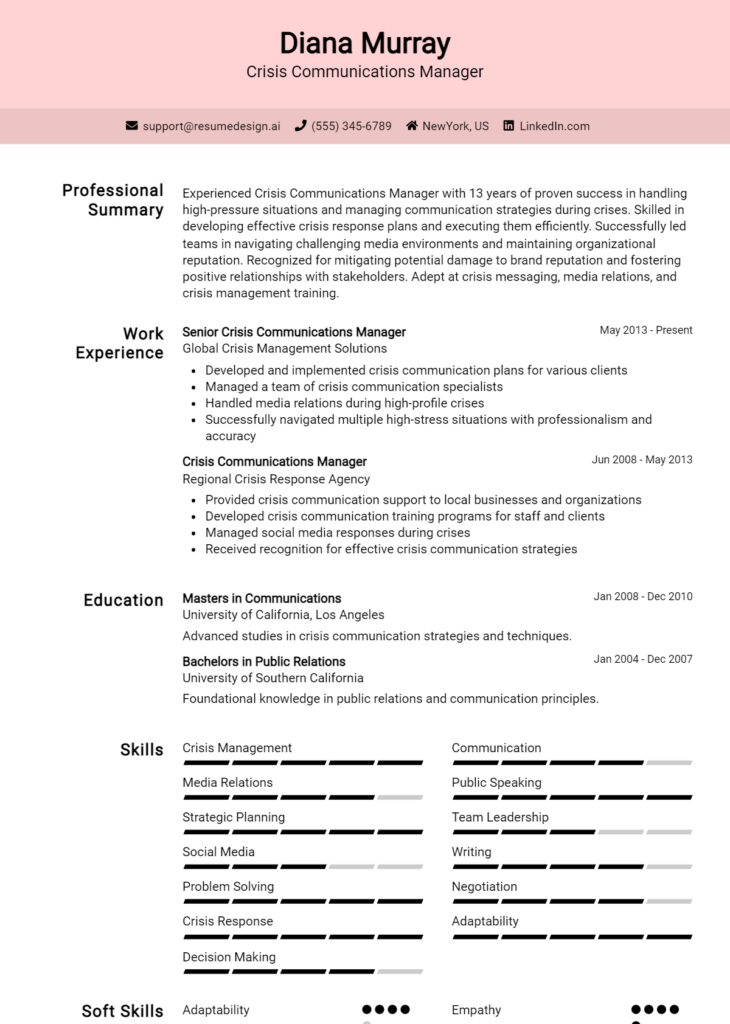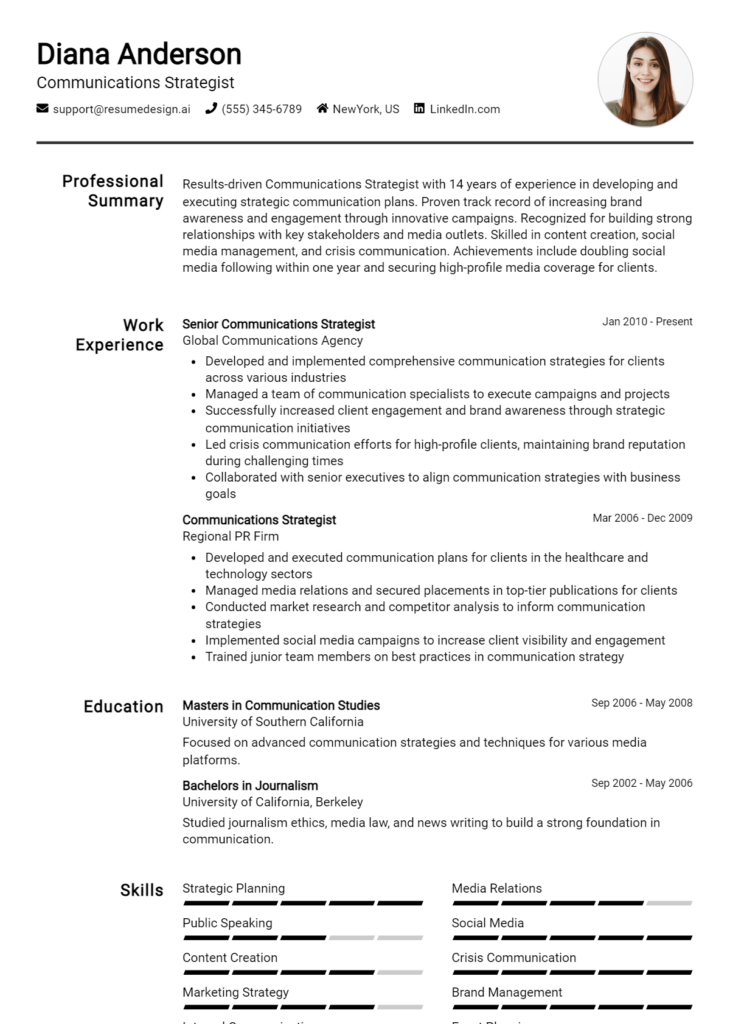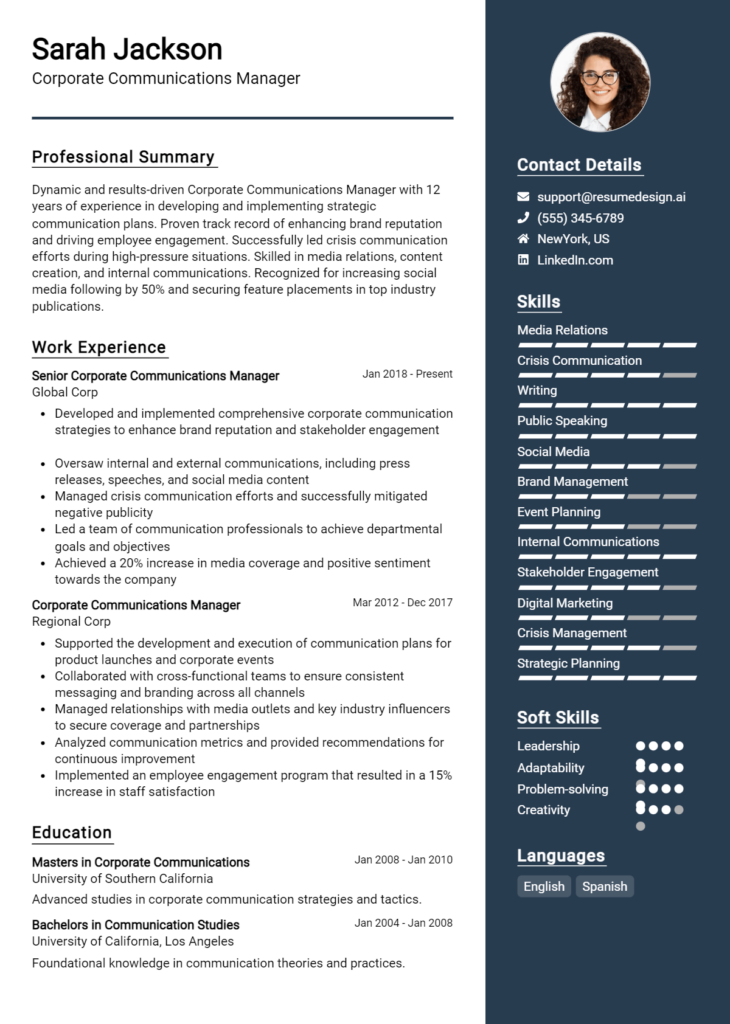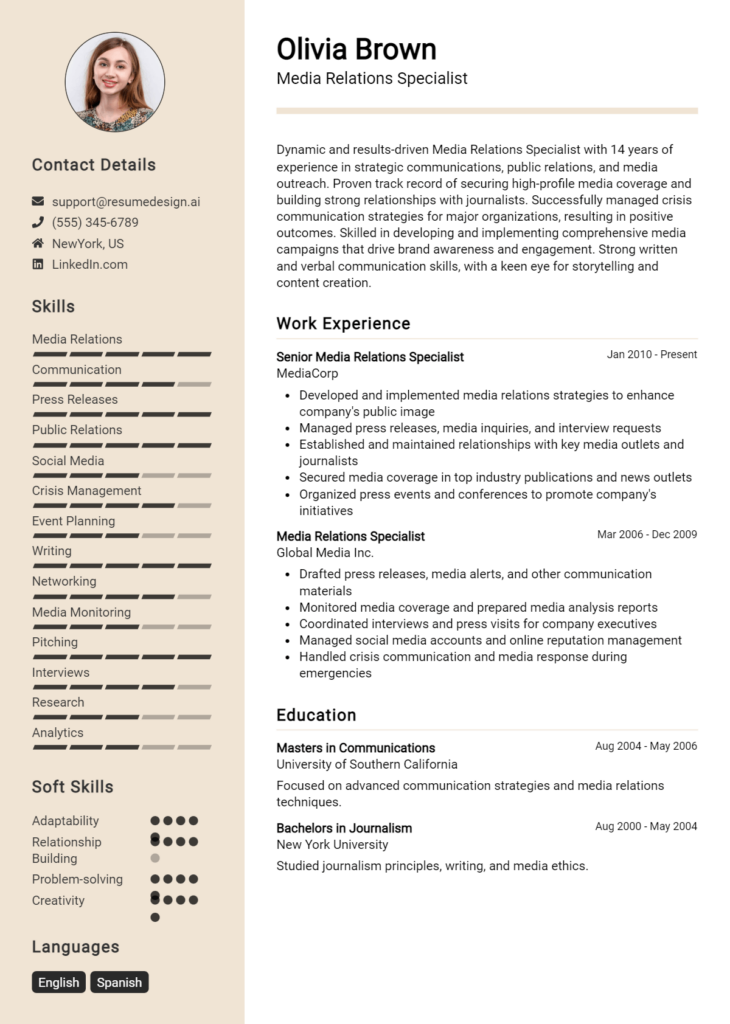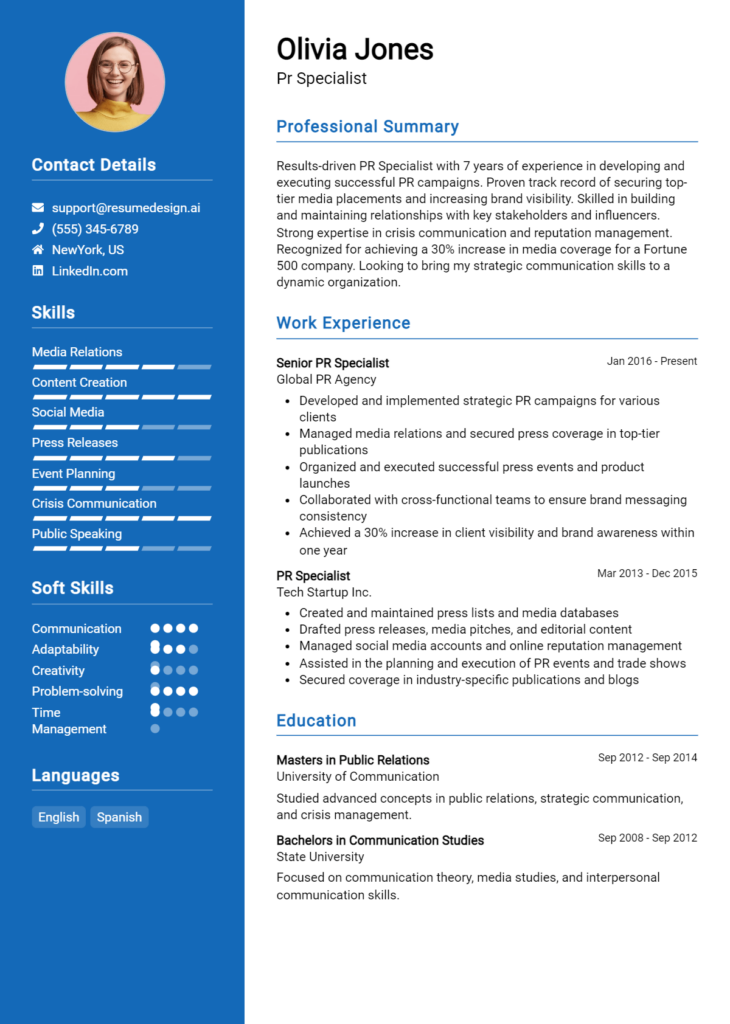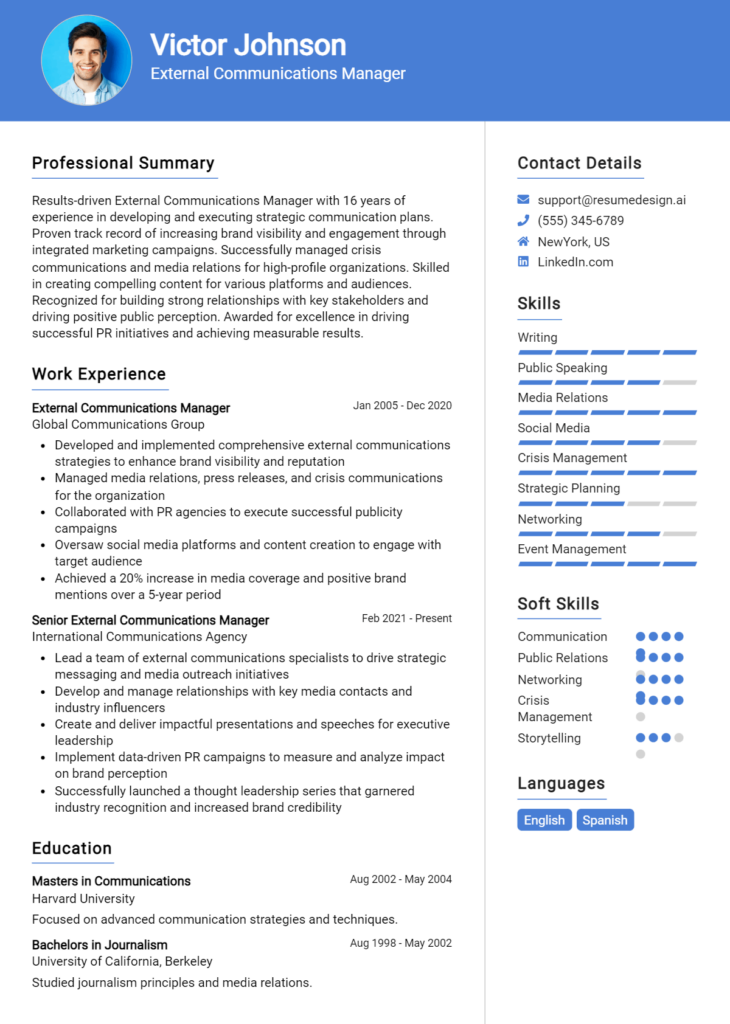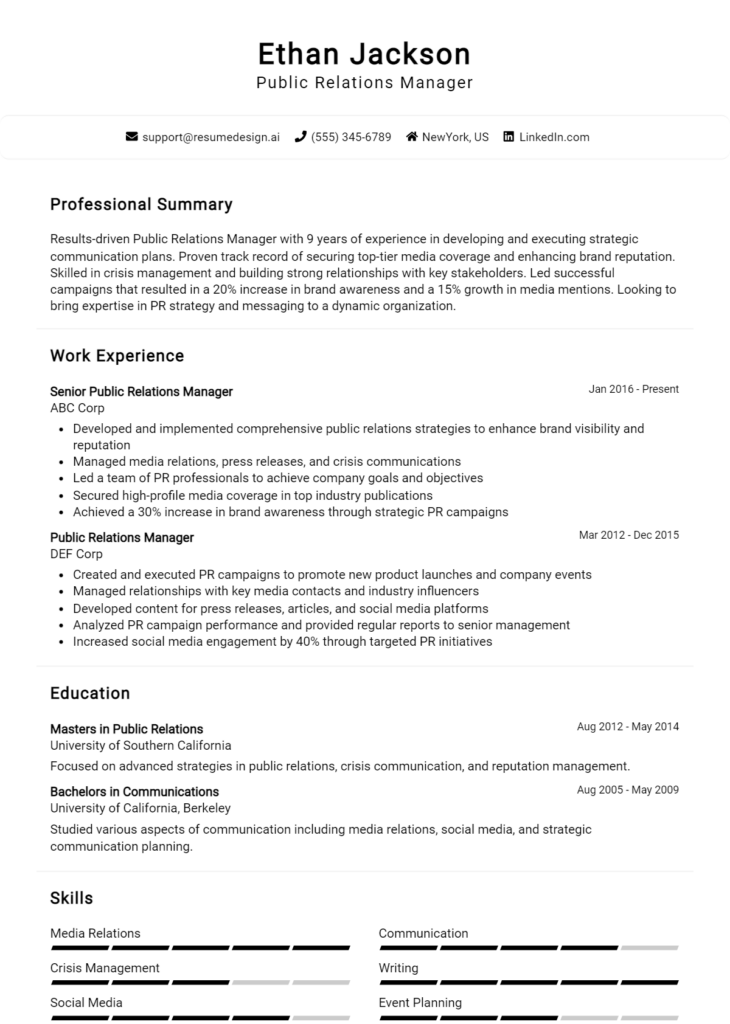PR Executive Core Responsibilities
A PR Executive plays a vital role in fostering communication between an organization and its various stakeholders, bridging departments such as marketing, sales, and customer service. Key responsibilities include crafting press releases, developing media relationships, and strategizing communication campaigns. Essential skills encompass technical proficiency in digital tools, operational efficiency, and strong problem-solving capabilities. These competencies significantly contribute to achieving organizational goals. A well-structured resume can effectively highlight these qualifications, showcasing a candidate's readiness to drive impactful public relations initiatives.
Common Responsibilities Listed on PR Executive Resume
- Develop and implement PR strategies and campaigns
- Write and distribute press releases, articles, and promotional materials
- Manage media relations and respond to inquiries
- Conduct market research to identify trends and opportunities
- Coordinate events and press conferences
- Monitor and analyze media coverage
- Collaborate with internal teams for unified messaging
- Manage crisis communication and reputation management
- Build and maintain relationships with key stakeholders
- Evaluate the effectiveness of PR initiatives
- Stay updated on industry trends and best practices
High-Level Resume Tips for PR Executive Professionals
In the competitive world of public relations, a well-crafted resume is not just a document; it’s your first handshake with potential employers. As a PR Executive, your resume needs to encapsulate your unique skills, accomplishments, and professional ethos within a few concise pages. It serves as your personal marketing tool, effectively communicating your ability to build relationships, manage reputations, and drive successful campaigns. This guide will provide practical and actionable resume tips specifically tailored for PR Executive professionals, ensuring that your first impression is a lasting one.
Top Resume Tips for PR Executive Professionals
- Tailor your resume to the job description by incorporating relevant keywords and phrases that align with the specific role.
- Showcase your relevant experience prominently, focusing on roles that highlight your strengths in communication, media relations, and crisis management.
- Quantify your achievements by using metrics and specific examples, such as "increased media coverage by 40%" or "managed a budget of $500,000 for a product launch."
- Highlight industry-specific skills such as social media management, event planning, and content creation to demonstrate your versatility.
- Use action verbs to begin each bullet point to convey a sense of proactivity, such as "developed," "coordinated," or "executed."
- Include a section for professional development, showcasing relevant certifications, workshops, or courses that enhance your expertise.
- Ensure your design is clean and professional, using clear headings and bullet points for easy readability.
- Incorporate a strong summary statement at the top of your resume that encapsulates your career highlights and aspirations.
- Keep your resume to one or two pages; conciseness is key in maintaining the reader's attention.
By implementing these tips, you can significantly increase your chances of landing a job in the PR Executive field. A well-structured and strategically crafted resume not only highlights your qualifications but also positions you as a standout candidate, ready to make a meaningful impact in the public relations industry.
Why Resume Headlines & Titles are Important for PR Executive
In the competitive field of public relations, a resume headline or title serves as the first impression a hiring manager receives from a candidate. It is a critical element that can immediately grab attention and succinctly summarize the candidate's key qualifications in a powerful phrase. A strong headline should be concise, relevant, and directly related to the job being applied for, allowing candidates to stand out in a crowded applicant pool. By effectively encapsulating their unique value proposition, PR Executives can set the tone for the rest of their resume and pique the interest of potential employers.
Best Practices for Crafting Resume Headlines for PR Executive
- Keep it concise; aim for one impactful phrase.
- Make it role-specific by including the job title.
- Highlight key skills or accomplishments relevant to PR.
- Use active language to convey confidence and proactivity.
- Avoid jargon or overly technical terms that may confuse.
- Incorporate quantifiable achievements when possible.
- Tailor the headline for each specific job application.
- Ensure it aligns with the overall tone and branding of your resume.
Example Resume Headlines for PR Executive
Strong Resume Headlines
Dynamic PR Executive with 5+ Years of Experience Boosting Brand Visibility
Results-Driven Communications Specialist Expert in Crisis Management and Media Relations
Award-Winning PR Strategist Focused on Digital Engagement and Audience Growth
Weak Resume Headlines
Experienced Professional Looking for a Job
Public Relations Resume
Strong headlines are effective because they encapsulate the candidate's strengths and achievements in a way that is clear and compelling, immediately drawing the attention of hiring managers. They provide a snapshot of what the candidate brings to the table, making it easier for employers to see the value in their application. Conversely, weak headlines fail to impress due to their vagueness and lack of specificity; they do not convey the candidate's unique qualifications or relevance to the role, causing them to blend in rather than stand out.
Writing an Exceptional PR Executive Resume Summary
A well-crafted resume summary is crucial for a PR Executive, as it serves as the first impression a hiring manager receives. This brief yet powerful introduction quickly captures attention by showcasing key skills, relevant experience, and notable accomplishments that align with the job role. A strong summary should be concise, impactful, and tailored to the specific position, allowing candidates to highlight their unique qualifications and set themselves apart in a competitive job market.
Best Practices for Writing a PR Executive Resume Summary
- Quantify Achievements: Use numbers and metrics to demonstrate the impact of your work, such as increased media coverage or successful campaigns.
- Focus on Key Skills: Highlight essential skills relevant to public relations, such as communication, crisis management, and media relations.
- Tailor for the Job Description: Customize your summary to align with the specific requirements and responsibilities outlined in the job posting.
- Keep it Concise: Aim for 2-4 sentences that deliver a powerful message without unnecessary details.
- Use Action Verbs: Start sentences with strong action verbs to convey confidence and initiative.
- Include Industry Keywords: Incorporate relevant keywords from the job description to pass through Applicant Tracking Systems (ATS).
- Showcase Unique Selling Points: Identify what makes you stand out, such as specialized knowledge or unique experiences in the PR field.
- Maintain a Professional Tone: Ensure your writing style reflects professionalism and aligns with the standards of the public relations industry.
Example PR Executive Resume Summaries
Strong Resume Summaries
Dynamic PR Executive with over 8 years of experience in strategic communications, having increased media coverage by 150% for Fortune 500 clients through innovative campaigns and targeted outreach.
Results-driven PR professional with a proven track record of managing crisis communications and achieving a 30% increase in positive media sentiment during high-pressure situations at a leading tech firm.
Creative and detail-oriented PR Executive with expertise in digital media strategies that drove a 200% increase in social media engagement for a nonprofit organization, enhancing brand visibility and community outreach.
Experienced PR strategist with a background in event management, successfully executing over 50 high-profile events that garnered national press coverage and increased stakeholder engagement by 40%.
Weak Resume Summaries
Public relations professional with experience in various roles looking for a challenging position in a reputable company.
Dedicated PR Executive with some experience in media relations and communication. Aiming to leverage skills in a new job opportunity.
The examples of strong resume summaries stand out due to their clarity and specificity. They quantify achievements, highlight relevant skills, and are tailored to the public relations field, which demonstrates the candidate's suitability for the role. In contrast, the weak resume summaries lack detail and measurable outcomes, making them generic and less impactful. They fail to convey the candidate's unique qualifications or how they can add value to a potential employer.
Work Experience Section for PR Executive Resume
The work experience section of a PR Executive resume is critical in demonstrating the candidate's technical skills, leadership abilities, and overall effectiveness in delivering quality results. This section not only highlights past roles and responsibilities but also serves as a platform to quantify achievements and align experiences with industry standards. By illustrating how they have successfully managed teams and executed PR campaigns, candidates can effectively showcase their capacity to drive brand growth and public engagement, making this section a vital component of their professional narrative.
Best Practices for PR Executive Work Experience
- Focus on quantifiable achievements to demonstrate the impact of your work.
- Highlight specific technical skills relevant to the PR industry, such as media relations, crisis management, and digital communications.
- Emphasize leadership and team management experiences to showcase your ability to guide and motivate teams.
- Align your work experiences with industry standards and best practices to enhance credibility.
- Use action verbs to convey a sense of proactivity and initiative in your roles.
- Incorporate examples of collaboration with cross-functional teams to illustrate teamwork and communication skills.
- Tailor your experiences to match the job description of the position you are applying for.
- Keep descriptions concise while ensuring clarity and relevance to the PR domain.
Example Work Experiences for PR Executive
Strong Experiences
- Led a team of 10 in a successful PR campaign that increased brand visibility by 40% over six months, resulting in a 25% increase in customer engagement.
- Developed and executed a crisis communication strategy that mitigated negative press and improved public perception by 30% within three months.
- Managed a $150,000 PR budget, optimizing resource allocation that led to a 50% reduction in costs while maintaining high-quality deliverables.
- Collaborated with marketing and social media teams to launch a multi-channel campaign, achieving a 60% increase in website traffic during the campaign period.
Weak Experiences
- Worked on various PR projects.
- Assisted in managing social media accounts.
- Helped with press releases and other communication materials.
- Participated in team meetings regarding PR strategies.
The examples listed above are considered strong or weak based on their specificity and impact. Strong experiences are characterized by clear, quantifiable results and demonstrate leadership, technical skills, and the ability to collaborate effectively. In contrast, weak experiences tend to be vague and lack measurable outcomes, making it difficult for potential employers to gauge the candidate's true contributions and capabilities in the PR field.
Education and Certifications Section for PR Executive Resume
The education and certifications section of a PR Executive resume is crucial for establishing a candidate's credibility and expertise in the field. This section provides insight into the candidate's academic background, relevant certifications, and commitment to continuous learning, all of which are essential in the fast-evolving landscape of public relations. By highlighting pertinent coursework, industry-recognized certifications, and specialized training, candidates can demonstrate their preparedness for the role and their alignment with the specific demands of the position. A well-crafted education and certifications section can significantly bolster a candidate's profile, making them more appealing to potential employers.
Best Practices for PR Executive Education and Certifications
- Include degrees from accredited institutions relevant to communications, marketing, or public relations.
- List industry-recognized certifications, such as APR (Accredited in Public Relations) or PRSA certifications.
- Highlight relevant coursework that showcases skills in media relations, crisis communication, or digital marketing.
- Prioritize recent educational achievements to demonstrate ongoing professional development.
- Provide details on specialized training, workshops, or seminars related to emerging trends in PR.
- Use clear formatting with dates and details that enhance readability and comprehension.
- Tailor the section to align with the specific job description and requirements of the PR role.
- Consider including honors or awards received during education to further validate expertise.
Example Education and Certifications for PR Executive
Strong Examples
- Bachelor of Arts in Public Relations, University of Southern California, 2018
- Master of Science in Strategic Communication, Columbia University, 2020
- Accredited in Public Relations (APR), Public Relations Society of America, 2021
- Certification in Digital Marketing, HubSpot Academy, 2022
Weak Examples
- Bachelor of Arts in History, University of Texas, 2015
- Certificate in Graphic Design, Local Community College, 2019
- Certification in Microsoft Office, Completed 2016
- High School Diploma, Graduated 2012
The strong examples are considered effective because they directly relate to the skills and knowledge necessary for a PR Executive role, showcasing relevant degrees and certifications that indicate a solid foundation in public relations and strategic communication. In contrast, the weak examples lack relevance to the field of public relations, featuring outdated or unrelated qualifications that do not enhance the candidate's suitability for the position. By focusing on education and certifications that align with the job requirements, candidates can significantly strengthen their resumes.
Top Skills & Keywords for PR Executive Resume
As a PR Executive, your resume serves as a critical tool to showcase your abilities and expertise in managing public relations and communications strategies. Demonstrating a combination of hard and soft skills is essential for standing out in this competitive field. Employers are looking for candidates who not only possess technical knowledge but also have the interpersonal skills necessary to build relationships and navigate complex situations. Highlighting relevant skills on your resume is vital, as it provides potential employers with a snapshot of your qualifications and suitability for the role. For more insights on how to effectively present your skills, visit our skills section.
Top Hard & Soft Skills for PR Executive
Soft Skills
- Excellent communication skills
- Strong interpersonal skills
- Creativity and innovation
- Adaptability and flexibility
- Problem-solving abilities
- Team collaboration
- Time management
- Emotional intelligence
- Critical thinking
- Conflict resolution
Hard Skills
- Media relations expertise
- Knowledge of social media platforms
- Proficiency in content creation and editing
- Understanding of SEO principles
- Crisis management strategies
- Familiarity with public speaking
- Data analysis and reporting
- Proficient in PR software and tools
- Event planning and coordination
- Brand management
To further enhance your resume, consider including details about your work experience that demonstrate how you’ve applied these skills in real-world scenarios. This will provide a comprehensive view of your capabilities and your impact in previous roles.
Stand Out with a Winning PR Executive Cover Letter
I am writing to express my interest in the PR Executive position at [Company Name]. With a robust background in public relations, strategic communications, and media relations, I am excited about the opportunity to contribute to your team. My experience in crafting compelling narratives and managing brand reputations aligns seamlessly with the goals of your organization. I am particularly drawn to [Company Name] due to its commitment to innovation and excellence, values that resonate deeply with my professional ethos.
In my previous role at [Previous Company], I successfully developed and executed integrated PR campaigns that enhanced brand visibility and engagement. By utilizing a combination of traditional media outreach and digital marketing strategies, I was able to increase media coverage by over 30% within the first year. I pride myself on my ability to build strong relationships with journalists and influencers, which has been instrumental in securing featured placements and positive coverage for my clients. My strategic approach to crisis communications has also prepared me to handle challenging situations with poise and professionalism.
I am particularly adept at leveraging social media platforms to amplify brand messages and foster community engagement. By creating targeted content and utilizing analytics, I have consistently driven audience growth and brand loyalty. I am eager to bring my creative thinking and proactive mindset to [Company Name], where I believe I can make a significant impact in enhancing your public relations efforts.
Thank you for considering my application. I am looking forward to the opportunity to discuss how my skills and experiences align with the needs of your team. I am excited about the possibility of contributing to [Company Name] and am eager to bring my passion for public relations to your esteemed organization.
Common Mistakes to Avoid in a PR Executive Resume
When crafting a resume for a PR Executive position, it's crucial to present your skills and experiences effectively. Many candidates make common mistakes that can hinder their chances of landing an interview. Understanding these pitfalls can help you create a compelling resume that stands out to hiring managers in the competitive field of public relations. Here are some common mistakes to avoid:
Lack of Tailoring: Failing to customize your resume for the specific job application can make it seem generic. Highlight relevant experiences that align with the job description.
Overly Complex Language: Using jargon or overly complicated language can obscure your message. Aim for clarity and conciseness to ensure your achievements are easily understood.
Neglecting Metrics: Not including quantifiable achievements can weaken your impact. Use numbers, percentages, or specific outcomes to demonstrate your contributions, such as "increased media coverage by 40%."
Focusing on Duties Instead of Achievements: Listing job responsibilities without showcasing accomplishments can make your resume less compelling. Emphasize what you achieved in each role rather than just what you were tasked with.
Ignoring Formatting: A cluttered or unprofessional format can detract from your content. Use a clean, organized layout with consistent fonts and spacing to enhance readability.
Omitting Soft Skills: Public relations often relies on interpersonal abilities and communication skills. Don't forget to include relevant soft skills that demonstrate your capability to build relationships and manage crises.
Using a One-Size-Fits-All Approach: Submitting the same resume for multiple applications can lead to missed opportunities. Tailor your resume to highlight the most relevant skills and experiences for each specific role.
Excessive Length: While it’s important to include relevant details, overly lengthy resumes can deter hiring managers. Aim for a concise document that succinctly conveys your qualifications, ideally fitting onto one page.
Conclusion
As a PR Executive, your role is vital in shaping and maintaining a positive public image for your organization. Throughout this article, we explored the essential skills required for success in this position, including exceptional communication, strategic planning, and media relations expertise. We also discussed the importance of building and nurturing relationships with journalists and influencers, as well as the need for adaptability in a rapidly changing media landscape.
In addition, we highlighted the significance of leveraging social media platforms to engage with audiences and manage brand reputation effectively. A successful PR Executive must also be adept at crisis management, ensuring that any negative publicity is handled promptly and appropriately.
To excel in your career as a PR Executive, it's crucial to present a polished and professional resume that reflects your skills and experiences accurately. We encourage you to take a moment to review your PR Executive Resume and ensure it showcases your qualifications in the best light.
To assist you in this process, consider utilizing the following resources:
- Resume Templates: Choose from a variety of professionally designed templates to make your resume stand out.
- Resume Builder: Create a customized resume effortlessly using our user-friendly builder.
- Resume Examples: Gain inspiration from real examples tailored for PR professionals.
- Cover Letter Templates: Complement your resume with a compelling cover letter that highlights your unique qualifications.
Take advantage of these tools today and elevate your PR career by ensuring your resume is as impressive as your skills and experience!

